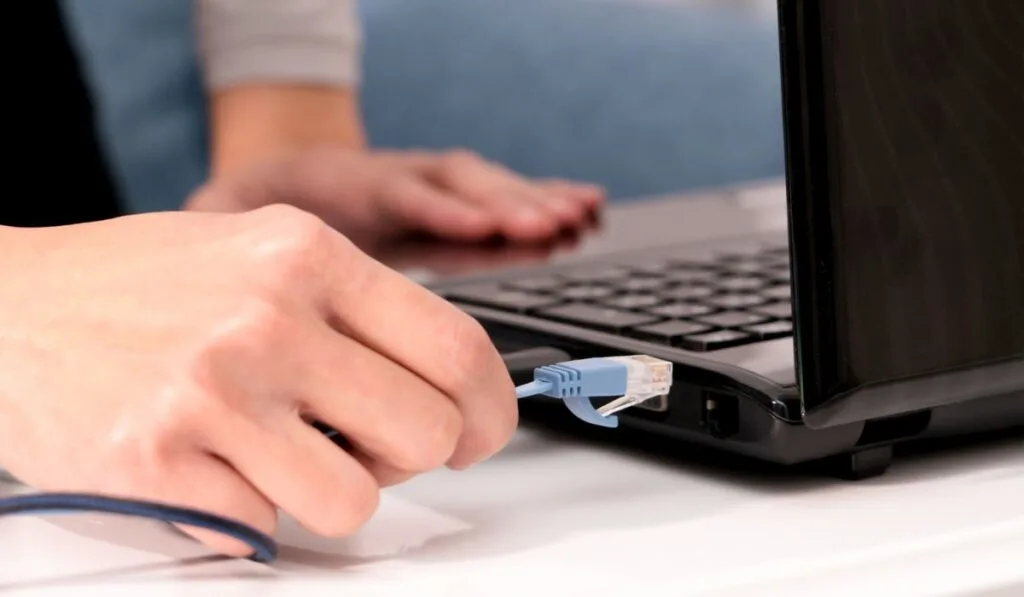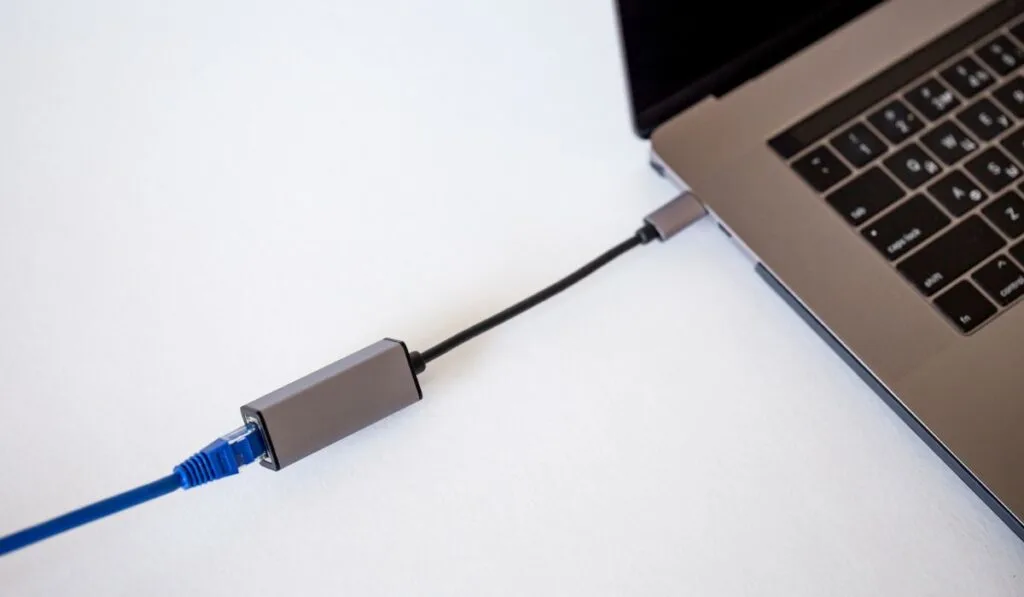Before WiFi became so commonplace, most people connected to the internet using an Ethernet cable that transmitted the data. Connecting your laptop or PC to your modem via an Ethernet cable is still possible, but how exactly does it work?
An Ethernet cable can be used to achieve an internet connection that is typically more reliable and stable than a WiFi connection. Ethernet is still common in some offices and among gamers. If your laptop doesn’t have an Ethernet port, an adapter can be used.
Ethernet offers certain benefits that WiFi doesn’t, including a high level of stability and reliability. Let’s take a closer at ethernet cables, how they work, and why you may benefit from using one on your computer.
What Is an Ethernet Cable?

You can use an Ethernet cable to connect various devices to the internet. The cable connects them directly to your modem.
In theory, this wired connection offers a more stable network. But unfortunately, not all Ethernet cables are the same.
Over the years, the transfer rate of new Ethernet iterations has steadily increased. Decades ago, the transfer rate of parallel connection ranged in the low kilobytes.
Today, some ethernet cables boast gigabyte transfer rates. The latest standard is CAT8, which has a transfer rate of 25/40Gbps 2,000MHz.
How to Differentiate Ethernet Cables
One of the tricky things about Ethernet cables is that they all look the same. The only identification you’ll see on a cable is a repeated line of letters and digits.
Within those lines, you should be able to spot the identifiers CAT5, CAT5E, CAT6, CAT6E, or CAT7. The transfer speed works as follows:
- Cat5 10/100Mbps 100MHz
- Cat5e 1,000Mbps 100MHz
- Cat6 1,000Mbps 250MHz
- Cat6a 10Gbps 500MHz
- Cat7 10Gbps 600MHz
- Cat8 25/40Gbps 2,000MHz
If these specifications mean nothing to you, don’t worry. You can derive the actual maximum speed by looking at the Mbps or Gbps. These stand for megabits per second and gigabits per second.
Although only a single letter differentiates the terms, they refer to two different units of measurement.
The standard Mbps doesn’t measure megabytes per second. Instead, it measures megabits per second.
A Misleading Measurement
One byte of data contains eight bits of data. Most ISPs use the megabits measurement because eight bits multiplied by any value sounds more impressive than one byte per second.
If you set up your network using these same methods, a connection speed of 800 Mbps is just 100 Mbps.
A Second Look At Cat Cable Speeds
The Cat5e cable runs at 1,000 Mbps. Here, you can spot another discrepancy. All bytes are made up of bits. There are eight bits in one byte.
You can’t multiply the number eight to produce a perfect amount of one thousand.
The real measurement for 1,000 Mbps is a transfer rate of 1,024 Mbps. The reason is simple. You can multiply the number eight by 128 to get 1,024. That is as close as one can get to one gigabit.
Because a bit is a smaller unit than a byte, your actual connection speed is 1,024 MBps divided by eight.
Your true connection speed comes to 128 megabytes. That sounds a lot less impressive than what your ISP might advertise. Furthermore, this discrepancy is key when buying the ethernet cables you need.
Why Would You Need to Use an Ethernet Cable on a Laptop?
There are several reasons why you might decide to use an Ethernet connection. The most common are:
- Your laptop’s WiFi isn’t functioning well
- The modem signal is blocked
- You need a stable, uninterrupted connection
- The router is damaged
- A router’s WiFi credentials are corrupt
- You’ve forgotten the WiFi password (The Ethernet connection will allow you to access your router settings and reset a forgotten password.)
Beyond internet connection issues, there are several other reasons why people use Ethernet cables, even in the age of WiFi:
For Work
You may need an ethernet cable to join an intranet. That is a private network that links trusted devices. Many companies do use these kinds of networks.
For Gaming
Before the internet could handle low-latency gaming connections, gamers would meet up for LAN (local area connection) parties. They would connect their computers to a splitter via Ethernet cables.
But even now, Ethernet cables are essential for competitive gaming. Unfortunately, WiFi connections can suffer brief dips in latency.
Therefore, a player that relies on a stable latency often prefers to connect their laptops and PCs to the modem directly via high-speed Ethernet cables.
How Do You Connect an Ethernet Cable to a Laptop?
The process is straightforward if your laptop has an Ethernet port. Simply plug the appropriate Ethernet cable into the Ethernet port on your laptop.
Then, connect the other end of the cable to the device with which you want to interface (usually a modem).
What if Your Laptop Doesn’t Have an Ethernet Port?
In the past, Ethernet connections were so important in computers that you would almost never find a PC or laptop without one. Of course, things have changed a lot since then.
Today, WiFi is the golden standard for connecting devices to the internet. WiFi is easier to set up, more convenient, and works with any smart device.
Most smart devices have no Ethernet port at all and instead only have a USB-C port.
It is this obsolescence that relegates Ethernet cables to a product that’s mostly used behind the curtains of network setups these days.
And this is why laptop manufacturers are phasing the Ethernet port out on newer laptops. Fortunately, there’s still a way to connect even the latest laptops to Ethernet cables.
How to Find the Correct Adapter for Your Laptop

New laptops typically come with two ports that you can use, and all that you need is the appropriate converter. These converters use USB ports to interface with an Ethernet cable.
The adapters are small devices, and there are models available for different USB ports. You can purchase a USB Type-C converter (on Amazon) for many of the latest phones.
If your laptop only has USB Type-A ports (the ports that you would associate with a USB thumb drive), you can find an adapter (on Amazon) for that as well. However, there is a caveat with USB Type-A ports: They need to have third-generation USB support.
Most importantly, you can identify a compatible port by its color. If you’re uncertain, it’s always best to get help from a professional.
